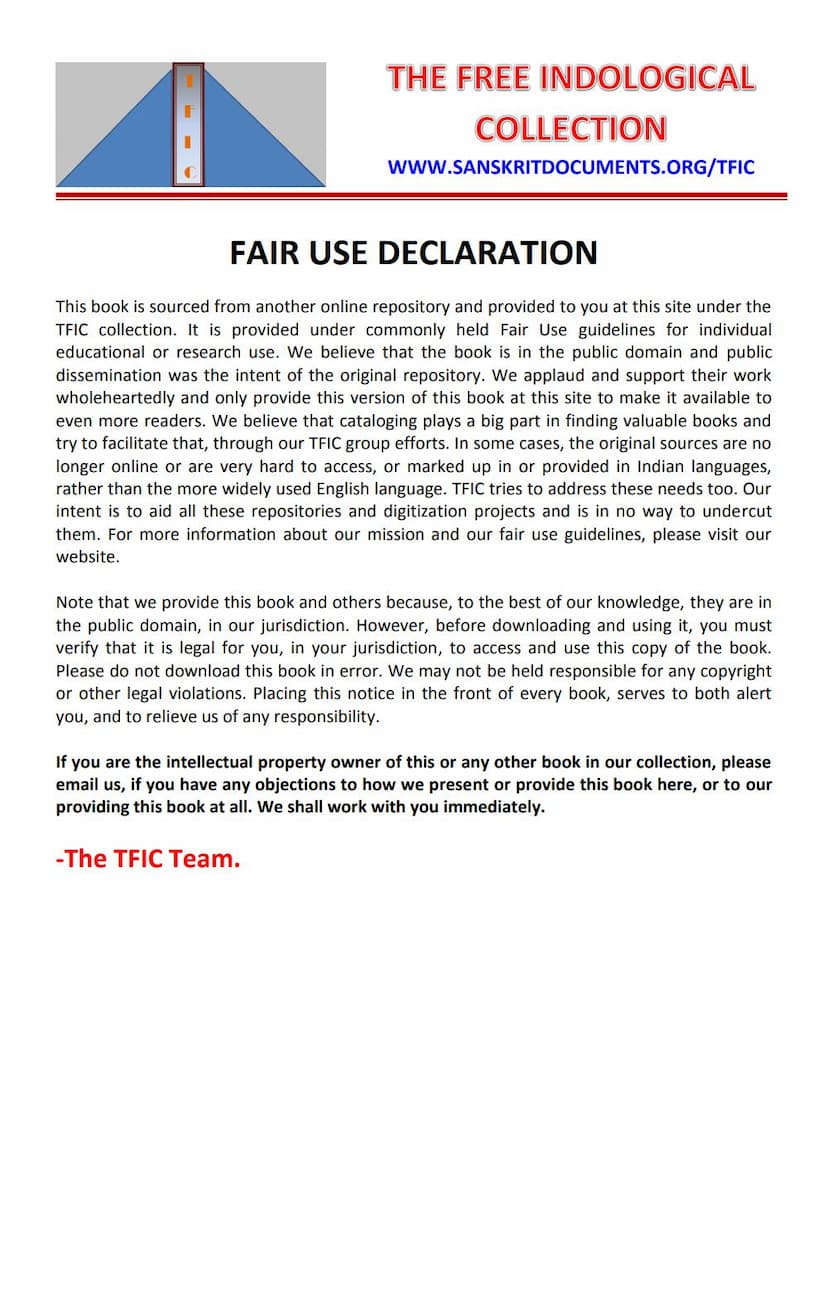Paraskar Gruhyasutram
Added to library: September 2, 2025

Summary
This document is a page from the Paraskaragṛhyasūtram, compiled by Mahadeva Gangadhara Bakre and published by Manilal Iccharam Desai. It contains the text of the Paraskaragṛhyasūtram with commentaries from Karka Upadhyaya, Jayarama, Harihara, Gadadhara, and Vishvanatha. It also includes appendices like the Vāpyādi-pratiṣṭhā kaṇḍikā, Śaucha Sūtra, Snāna Sūtra with Harihara Bhāṣya, Śrāddha Sūtra with commentaries, Kāśikā by Krishnamishra, and Bhojana Sūtra.
The provided excerpt specifically covers the first Kaṇḍikā (Chapter/Section) of the text.
Here's a breakdown of the key points from the excerpt:
Introduction and Context:
- The book is an edition of the Paraskara Grhya Sutra with multiple commentaries, aiming to make this significant text accessible to a wider audience.
- The Grhya Sutra traditionally deals with domestic rituals performed by the householder, as opposed to the Śrauta Sutras which are performed by a trained priest and involve fire offerings from the Śrauta or Vaitānika fires. However, the text clarifies that the Grhya Sutra here refers to rites performed on the Grhya or domestic fire, which encompasses the Āvasathya and Aupasana fires.
- The author, Mahadeva Gangadhara Bakre, expresses gratitude to those who helped in the process, mentioning specific individuals and libraries that provided manuscripts.
- The preface highlights the importance of the Grhya Sutra in detailing rites related to the various stages of life (saṁskāras) and daily observances.
Commentaries and their Features: The preface provides insights into the nature of the five commentaries:
- Karka (Karkopādhyāya): This commentary serves as the basis for others. Karka expounds the sutras, and Jayarama and others build upon it with further explanations. Karka explains the mantras.
- Jayarama: Jayarama elaborates on the sutras, explaining the mantras.
- Harihara: Harihara explains the paṭhaddhati (methodology or ritual procedure) and other necessary details.
- Gadadhara: Gadadhara elaborates on the mantras, describes the paṭhaddhati, explains auspicious and inauspicious timings based on astrology (jyotiṣaśāstra), and incorporates details from other texts, such as mentioning Arka Vivāha (marriage to a pitcher) alongside marriage, and rituals for menarche and twin births.
- Vishvanatha: Vishvanatha presents his commentary through extensive explanations, refuting opposing views (paramata nirākarot), and providing specific applications (prayoga) where necessary.
Content of the First Kaṇḍikā (as outlined in the index): The index lists the topics covered in the Paraskara Grhya Sutra:
- First Kāṇḍa (Chapters/Sections):
- General rules for Homa (fire sacrifice).
- Rules for establishing the Āvasathya fire.
- Rules for offering samidh (fuel sticks).
- Rules for begging and holding a staff and animal skin (celibate student rules).
- Marriage rites (Vivāha vidhiḥ).
- Rules for Samāvartana (student's return home).
- Rules for Aupāsana Homa.
- Rules for the student's vows until household life.
- Rituals for the first visit to the husband's house after marriage (including prāyaśchittiḥ for separation).
- Chaturthī Karma (a ritual after marriage).
- Pāka Karma (kitchen rituals, including Darśapūrṇamāsa sthālipāka).
- Determination of Purnimas (full moon days).
- Rituals suitable for repetition.
- Rituals for conception.
- Puṁsavan (rite for male fetus).
- Sīmantonnayana (rite for parting the hair).
- Soḍyantī Karma (rite for easy delivery).
- Medhājanana (rite for intellect) and Āyuṣyakaraṇa (rite for long life).
- Rakṣāvidhiḥ (protection ritual).
- Naming ceremony (Nāmakaraṇa).
- Niṣkramaṇa (first outing).
- Annanprāśana (first rice feeding).
- Sūryāvekṣaṇa (viewing the sun).
- Prosya āgatasya karma (ritual upon returning from abroad).
- Aṣṭakāḥ (rituals performed on specific days in autumn).
- Chūḍākaraṇa (hair cutting ceremony).
- Keśānta (hair trimming ceremony).
Specific Sutra and Commentary Details (Example from the beginning): The text then begins with the sutras themselves, followed by the commentaries.
- Sutra 1: Athāto gṛhyasthālipākānāṁ karma (Now, then, about the ritual of sthālipāka for domestic purposes).
- Karka's Commentary: Explains the atha (introduction, signifies consecution), ataḥ (therefore, signifying the reason for discussing these rites after the Śrauta ones), and the term gṛhya referring to the domestic fire. It also touches upon the debate of whether Smārta rites precede or follow Śrauta rites, leaning towards the latter due to direct scriptural evidence.
- Jayarama's Commentary: Similar to Karka, Jayarama also explains the introductory words and the śrauta-smārta sequence, emphasizing the directness of Śruti over inference for Śrauta rites.
- Harihara's Commentary: Details the Āvasathya fire and its establishment (ādhāna) at the time of marriage (dārakāla). It discusses the timing of this ritual, mentioning the debate about performing it before or after certain marriage ceremonies. It also touches upon alternative times like the division of ancestral property (dāyādya kāla).
- Gadadhara's Commentary: Engages in the philosophical discussion about the Śrauta and Smārta distinction, asserting the authority of Smṛti due to its unbroken tradition. It also delves into the meticulous details of preparatory rituals like parisamūhana (sweeping around the fire altar), upalepana (applying cow dung paste), etc., explaining their purpose and significance.
- Vishvanatha's Commentary: Focuses on the interpretation of the sutras, the role of commentaries, and the logical necessity of precise explanations (nyāya nirūpaṇā). It also discusses the meaning of atha and ataḥ in this context.
Fair Use Declaration: The beginning of the document includes a "Fair Use Declaration" from "THE FREE INDOLOGICAL COLLECTION WWW.SANSKRITDOCUMENTS.ORG/TFIC." It states that the book is sourced from another online repository, provided for individual educational or research use under Fair Use guidelines, and believed to be in the public domain. TFIC applauds and supports the work of other digitization projects and aims to make valuable books accessible, especially those in Indian languages that might be hard to access or no longer online. They emphasize that users must verify the legality of downloading and using the book in their own jurisdiction and that TFIC is not responsible for any copyright or legal violations. They also invite intellectual property owners to contact them if they have objections.
In essence, the document is a scholarly edition of a foundational Jain text on domestic rituals, providing a comprehensive summary and detailed explanations from multiple ancient commentaries, highlighting the procedural and philosophical nuances of these practices.